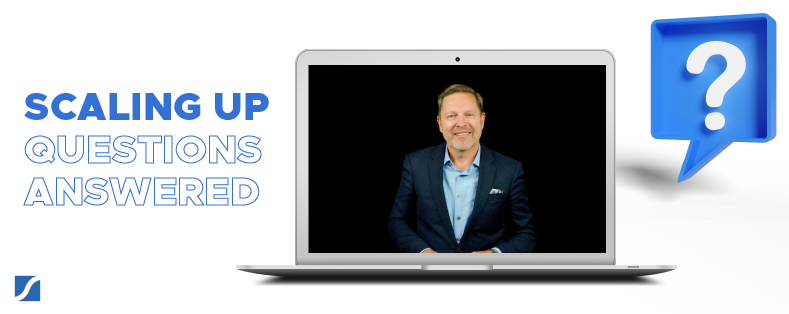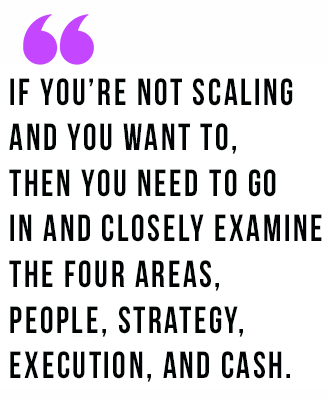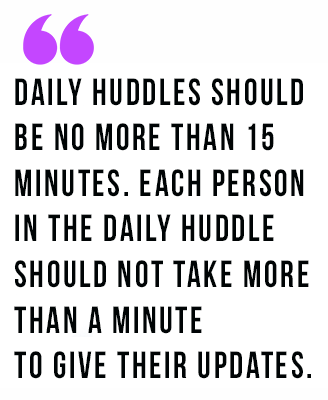11 Questions You Might Have On the Scaling Up Methodology


Many business leaders who are interested in Scaling Up initially have a lot of questions.
The methodology can be quite detailed, and that's perfectly normal.
So in this article, I'm answering the most pressing questions about the methodology, so you can take action and start implementing today.
Here's what we're covering:
- How often does the One-Page Strategic Plan (OPSP) need updating?
- How do you determine where to start with the scaling up process?
- I want to scale up but I don’t feel like I’m ready - What should I do?
- How do you know when your company is ready to scale?
- How do you scale up without actually burning out?
- How do we create a performance culture to drive growth?
- Do you have any insights on how to create good metrics?
- How would you get your business partner to buy into the scaling up methods?
- Should the daily huddles be more relaxed or speedy?
- What's the number one thing that blocks companies from scaling up?
- Is it possible to scale up a business with seasonal swing?
1. How often does the One-Page Strategic Plan (OPSP) need updating?
At least annually.Quarterly is the usual rhythm. A lot of companies update the OPSP every two months.
If you’re growing single digits a year, you're probably okay with just the annual plan—and that's the minimum. If you're running at 10 to 15% growth, you really need to look at it quarterly. And if you're growing at something like 50-100% a year, you really need to look at it at least every two months.
2. How do you determine where to start with the scaling up process?
There are four main areas you want to look at:People, Strategy, Execution, and Cash.
If it looks like you're going to run out of cash this Friday, then you better get focused on cash. Or if you’re missing some key players on the team or have run into some partner issues, then you need to address those first or you won’t have the emotional energy to deal with the rest.
The best way to figure out with your team which area you need to focus on next, is to look deeply at those 4 key decisions and identify which one you're most struggling with today.
3. I want to scale up but I don’t feel like I’m ready - What should I do?
I wish there was something between startup and scale up, but there isn’t. You can just decide to be a small business. We know that 96% of small businesses in the United States are under a million in revenue.But when you decide you really want to scale, and that is when you have a decent annual growth of 10-20% or more, then that’s when our Scaling Up ideas really start to kick in.
4. How do you know when your company is ready to scale?
First, the best indicator is your market. If you have a lot of people wanting something from you, and you're just trying to run to keep up, then it’s time to scale up.
If you don’t, you will either leave money on the table or your organization will burn out.
Second, you've got to be mentally prepared to scale.
Because there are a lot of additional challenges that come with scaling up.
Third, if you’re not scaling and you want to, then you need to go in and closely examine the four areas, People, Strategy, Execution, and Cash.
All four need to be in place to handle the scaling and get yourself prepared to grow.
5. How do you scale up without actually burning out?
Well, that's why I wrote Scaling Up.
Because I saw folks working 60 to 80-hour workweek just spinning the wheels. In the opening chapter of the book, I talk about this leader, Alan Rudy, who was working these long hours.
Then, he used our Scaling Up tools and was able to basically run the company one day a week while still allowing him to do things out in the marketplace.
Watch the video to hear me dive these questions into more detail
6. How do we create a performance culture to drive growth?
The fundamentals begin with the 10 Rockefeller Habits.Imagine if you had a heating air conditioning system without a thermostat. It would just run wild, right? We would be uncomfortable, and it would waste a lot of energy and money.
Well, this describes a lot of people's companies. They waste a lot of money and energy, not much gets done, and everyone is just uncomfortable in the end.
Today, we have dashboarding tools that can act like your company’s thermostat so you’ll always know how your company is performing. So to me, the thermostat is our best analogy, and that's what the Rockefeller Habits are all about addressing.
And by the way, you don't have to have any of these habits in place.
But if you don’t, get ready to waste a lot of time and energy having to work 80-hour workweeks, and still not get the kind of outcomes or results that you're looking for!
7. Do you have any insights on how to create good metrics?
I'm a big fan of the book, Moneyball.When John Ratliff applied the “Moneyball” concept to his call center business, he discovered that his call centers with the lowest quality score actually had the highest customer retention, while the centers with the highest quality score actually had the lowest customer retention.
After John figured out what his Moneyball statistic was, he began to drive on that single statistic.
The result? His customer retention went up, his employee retention broke industry record levels by a factor of 10, and his company's performance was five times higher than the industry average in terms of his profitability.
So first, you want to find the right measure. And that just involves looking at a lot of correlations which machine learning and big data can help you do. Once you do that, get laser-focused on it.
8. How would you get your business partner to buy into the scaling up methods?
Rather than hand the book to a partner, pull out a few pages or chapters.I recommend getting them to read the “Barriers” chapter first. It’s a good, fun read that gets into the spirit of what Scaling Up is about.
Then have them read the “Core” chapter because it is core to the business.
Then, if they want to read more, have them read the execution section. This way will be much less daunting than being given a whole book to read.
9. Should the daily huddles be more relaxed or speedy?
It should align with your culture.
If you’re a fast-paced working culture, then that will be reflected in your meeting style. If you're more of a relaxed kind of laid-back culture, then obviously that's going to be felt in your meetings.
Generally, daily huddles should be no more than 15 minutes. Each person in the daily huddle should not take more than a minute to give updates.
In the beginning, it might feel rough because people take too long to explain things. But once it's up to speed and everyone gets the rhythm, it’s easy to stay on time.
To an outsider, it might look like a horse race. To people inside, it's a nice pace.
10. What's the number one thing that blocks companies from scaling up?
There's not just one thing.That's why we created the 4 main categories:
People, Strategy, Execution and Cash
Bill Gross of Idealab wanted to see which one of those four was more important.
His research came back with an interesting conclusion that it's like a table with four legs. All four are equal and if you're missing one of those legs, it can stand but it will be wobbly.
11. Is it possible to scale up a business with seasonal swing?
Yes, you can. A lot of companies would love to have this challenge, because it means you can spend six months preparing, then six months executing.
So businesses with seasonal swings allow you to take a rest and prepare.
A leader I know, Harrison, scaled his company to a billion dollars.
His company would experience a seasonal swing where the first three quarters of the year would require them to continually push for revenue, but the fourth quarter would be slow. Harrison used the time in the slower last quarter to let the system catch up.
Another thing you could do is acquire a business that is counter-cyclical so you can smooth out the flows. But I know plenty of folks with seasonal businesses who embrace the cycle. They make a year's worth of revenue in six months, then enjoy the time off. In that way, seasonal swings can be a blessing.
Conclusion
If you would like to learn more about any of the concepts I talked about here, check out more of our Scaling Up resources and tools.
Start with the decisions that make sense to you. Dive into the concepts, apply the tools, and iterate as you go.
Good luck! 



.png)
